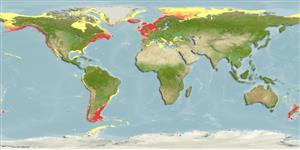Common names from other countries
Environment: milieu / climate zone / depth range / distribution range
Ecologia
; intervalo de profundidade 0 - 380 m (Ref. 83435). Temperate; 85°N - 57°S, 180°W - 43°E
Arctic, Atlantic, Eastern Pacific and the Mediterranean Sea. Subtropical to polar.
Length at first maturity / Tamanho / Peso / Idade
Maturity: Lm ? range ? - ? cm Max length : 10.0 cm TL macho/indeterminado; (Ref. 7726)
Assumed maximum length from Ref. 822. Known from intertidal to deep waters, in large aggregations of thirty or more individual adults (Ref. 7726). Free-living (Ref. 3123). Generally for group, planktonic and minute detrital food items through either suspension or deposit feeding (Ref. 87872). Feeds on various sea anemones (Ref. 822), particularly frilled anemone (Ref. 7726).
Life cycle and mating behavior
Maturidade | Reprodução | Desova | Ovos | Fecundidade | Larvas
Sexes are separate but are seldom conspicuously different externally, simultaneous hermaphrodites yet self-fertilization is prevented due to various morphological, physiological, or behavioral mechanisms; generally, marine gastropods shed their eggs (Ref. 87872).
Turgeon, D.D., J.F. Quinn Jr., A.E. Bogan, E.V. Coan, F.G. Hochberg, W.G. Lyons, P.M. Mikkelsen, R.J. Neves, C.F.E. Roper, G. Rosenberg, B. Roth, A. Scheltema, F.G. Thompson, M. Vecchione and J.D. Willams. 1998. (Ref. 1667)
Categoria na Lista Vermelha da IUCN (Ref. 130435)
Categoria CITES (Ref. 108899)
Not Evaluated
Not Evaluated
Utilização humana
| FishSource |
Ferramentas
Mais informação
Idade/Tamanho
Crescimento
Comprimento-peso
Comprimento-comprimento
Morfologia
Larvas
Abundância
Fontes da internet
Estimates based on models
Preferred temperature
(Ref.
115969): 2.4 - 11.8, mean 7.2 (based on 1479 cells).
Vulnerabilidade
Low vulnerability (10 of 100).
Categoria de preço
Unknown.
